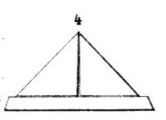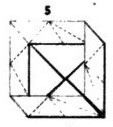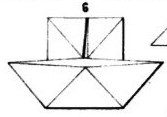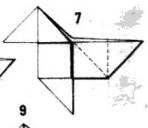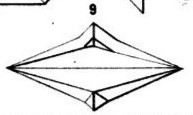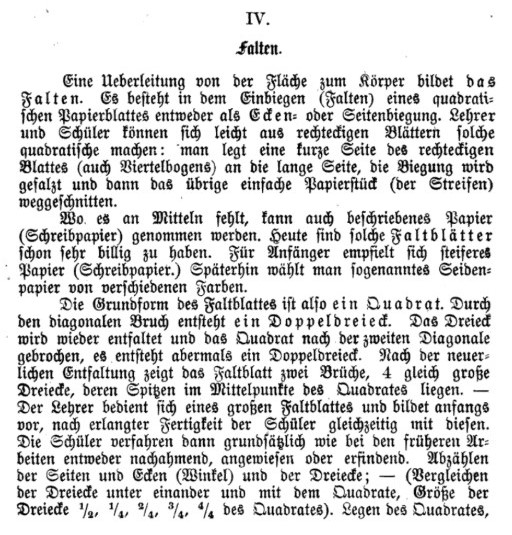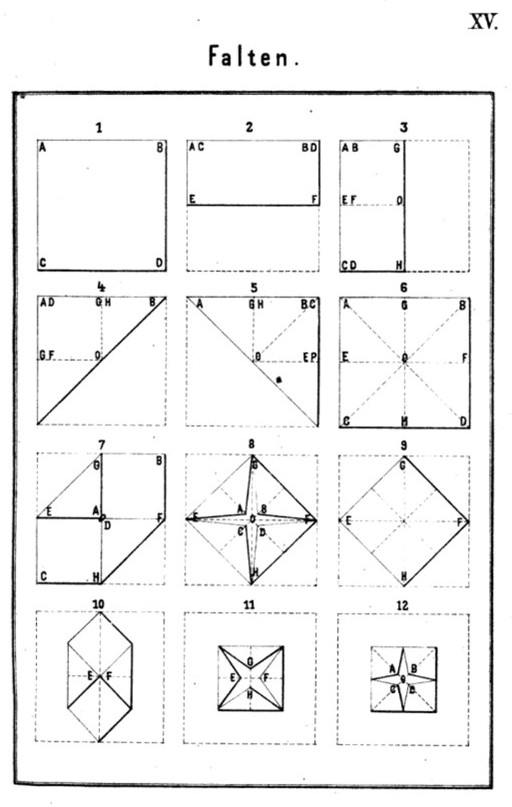| The Public Paperfolding History Project
Last updated 12/10/2025 x |
|||||||
| Praktischer Wegweiser fur den Unterricht in der Elementarklasse by Anton Fruhwirth, Alois Fellner and Georg Ernst, 1875 | |||||||
'Praktischer Wegweiser fur den Unterricht in der Elementarklasse' (Practical Guide for Teaching in the Elementary Class) by Anton Fruhwirth, Alois Fellner and Georg Ernst was first published by A Pichler's Witwe & Sohn in Vienna in 1872. (See here.) I have not been able to access a copy of this first edition. This page is based on the 2nd edition, published in 1875, which contains a brief section on Falten and two accompanying plates of illustrations of paperfolds. The pictures in these plates appear to have been extracted from plates that had previously appeared in the 1974 edition of 'Der Kindergarten' by Hermann Goldammer. The Preface to the 2nd edition states, inter alia, roughly translated: 'In the second edition the elementary class is covered and presented in its entirety and with regard to its important task. One chapter is devoted to Formenarbeiten, both theoretically and practically, and several other chapters ...' I take this to mean that the chapter on Formenarbeiten, which includes the section on Falten, is new and did not appear in the first edition. A full copy of the second edition can be accessed online here. **********
**********
********** Analysis The Preface states that folding is done from squares and explains how to obtain them individually from oblongs. For beginners stiff paper (writing paper) is recommended but 'Later tissue paper in various colours is preferred.' ********** Plate XV shows the basic Erkenntisformen folds, which are explained in detail in the text, and how to create the Double Blintz Basic Form, which is not mentioned. ********** Plate XVI shows a number of Schonheitsformen. These again are not mentioned in the text. Forms 1a to 1h are developed from one side of the Double Blintz Basic Form and forms 2a to 2d from the other. Forms 3a and 3b are developed from the Windmill Base, which is not mentioned or explained. ********** Pictures 4 to 9 show various unnamed Folds of Life, which again are not specifically mentioned or explained, although the text says: 'By continuously folding the pages open and closed ... the most diverse forms of life are created (trousers, jacket, ship, pepper and salt cellar, piglet). The folding work is also ideal for homework.' Pictures 4 to 9 show: 4. The Newspaper Hat
********** 5. The Blintz Box
********** 6. The Cup and Saucer
********** 7. The Cocotte / Pajarita
********** 8. The Double Boat
********** 9. The Bellows
********** In the course of explaining the basic folds the text also says: 'By unfolding one part (ie one flap of a blintzed square) ... a house is created' and 'The unfolded parts can now lie in the plane of the square (ie completely unfolded) or have an inclination towards it. The square is placed on the triangles that have been opened upright (Table with tablecloth) ... Other shapes cannot easily be described, they must rather be learned practically' and 'The folded sheet ... forms a roof by tilting and positioning the parts', all are references to what we can call Simple Folds of Life.
********** |
|||||||



